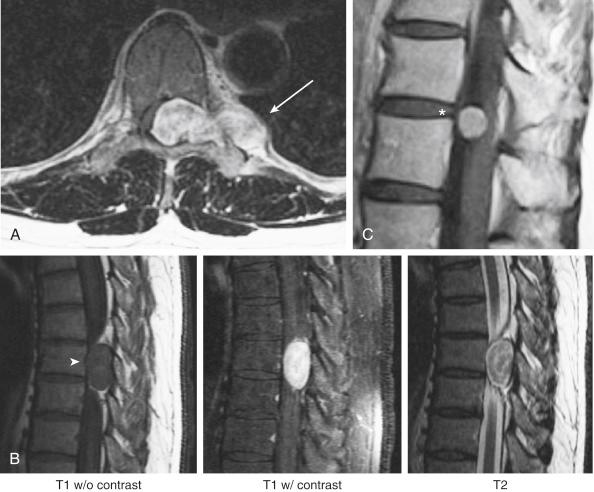Physical Address
304 North Cardinal St.
Dorchester Center, MA 02124
|
|
|
|
Spinal cord tumors account for an estimated 5% to 15% of all central nervous system (CNS) tumors, with an incidence of 0.5 to 2.5 cases per 100,000. Among these, nearly 50% are primary intradural spinal cord tumors. Intradural spine tumors are divided into two main categories based on the anatomic origin of the lesion: intradural extramedullary spinal cord tumors (IESCTs), arising from within the spinal cord; and intramedullary spinal cord tumors (ISCTs), originating from the dura but located within the subarachnoid space.
IESCTs account for 80% of intraspinal tumors in adults and 65% to 70% of intraspinal tumors in children. The two most common types of IESCTs are nerve sheath tumors (NSTs) (30%) and meningiomas (25%). Because NSTs arise from perineural cells and Schwann cells, the two most common NSTs are schwannomas and neurofibromas; schwannomas account for approximately 65% of NSTs. Most NSTs are sporadic, but they are also common in the setting of inherited disorders such as neurofibromatosis type I (NF-1) and type 2 (NF-2). Sporadic NSTs usually arise in the fifth to seventh decade, whereas those in the setting of neurofibromatosis arise during childhood or early adulthood. Meningiomas originate from arachnoidal cells along the neuraxis and are also commonly associated with neurofibromatosis. However, only 10% of meningiomas arise external to the cranial fossa.
ISCTs account for 20% of intraspinal tumors in adults and 30% to 35% of intraspinal tumors in children. The two most common ISCTs are ependymomas (60%) and astrocytomas (30%). Ependymomas mainly arise in adults in approximately the third or fourth decade, and astrocytomas usually appear in children during the first decade. Given the predominant prevalence of ependymomas and astrocytomas, investigators believe that most ISCTs are of glial origin This chapter discusses the anatomic distribution, presentation, diagnosis, and management of the most common types of spinal cord tumors, including both IESCTs and ISCTs.
IESCTs have a nonspecific clinical presentation that includes axial back or neck pain, as well as radicular or myelopathic signs and symptoms. Associated pain is usually most intense in the evening and morning. The specific symptoms of IESCTs mainly depend on the level involved and have no specific anatomic distribution. A study performed by Slin’ko and Al-Qashqish, however, examined 360 patients with IESCTs over an 11-year period and classified tumor location on both the axial and the longitudinal axis. The investigators found that on the longitudinal axis, most IESCTs occurred within the thoracic spine, followed by the cervical and lumbar spine, respectively. On the axial axis, the investigators determined that most lesions occurred on the dorsolateral division, followed, respectively, by the ventrolateral, dorsal, and ventral divisions.
In the case of NSTs, radicular sensory signs are the first to follow pain. Patients have pain because NSTs characteristically arise in the dorsal sensory roots. Radiculopathy with motor deficits is not common, even during involvement of functional roots of the cervical or lumbar spine. However, myelopathic motor signs manifest once the tumor achieves a critical mass, thus resulting in spinal cord compression. The myelopathy has no distinctive symptoms and may include signs such as Brown-Séquard syndrome (ipsilateral hemiplegia with ipsilateral fine touch sensory deficit and contralateral pain and temperature sensory deficit, and upper motor neuron involvement such as upward plantar reflex, hyperreflexia, and clonus). Chronicling the time progression of symptoms is important because rapidly worsening signs and symptoms indicate the presence of a fast-growing, aggressive tumor such as a malignant NST (MNST). Similarly, the presentation of spinal meningiomas is nonspecific and includes signs and symptoms such as progressive lower extremity numbness and weakness. Furthermore, many spinal meningiomas are often asymptomatic as a result of their slow growth and are discovered only incidentally during an imaging study or at autopsy.
The two most common types of IESCTs are NSTs and meningiomas. The diagnosis of IESCTs is best made using magnetic resonance imaging (MRI) because plain radiography, computed tomography (CT), and CT with myelography do not provide sufficient delineation of an intradural neoplasm. However, when MRI is contraindicated, CT with myelography is the imaging modality of choice.
Of primary importance is determining whether the neoplasm is intramedullary or extramedullary. Extramedullary neoplasms have the following characteristics on MRI: displacement and compression of the spinal cord, expansion of the thecal sac, and a menisci-like interface with the cerebrospinal fluid. Intramedullary neoplasms are characterized by expansion of the spinal cord.
Most IESCTs are isointense to the spinal cord on T1-weighted imaging and hyperintense on T2-weighted images. Furthermore, IESCTs typically enhance with contrast on T1-weighted imaging ( Fig. 22-1 ). NSTs produce unique “target lesions” on MRI that correspond to the pathologic anatomy of the lesion. Despite the optimal ability of MRI to delineate the anatomic interface between the spinal cord and the neoplasm, this modality cannot provide a definitive diagnosis; the differential diagnosis also includes meningiomas, extramedullary ependymomas, mixed cell gliomas, hemangiomas, and cavernous hemangiomas. Definitive diagnosis is usually not made until pathologic examination of the surgical specimen. Patients with a positively identified IESCT should undergo further MRI of the remaining neuraxis to search for additional lesions, particularly in the setting of neurofibromatosis.

Become a Clinical Tree membership for Full access and enjoy Unlimited articles
If you are a member. Log in here